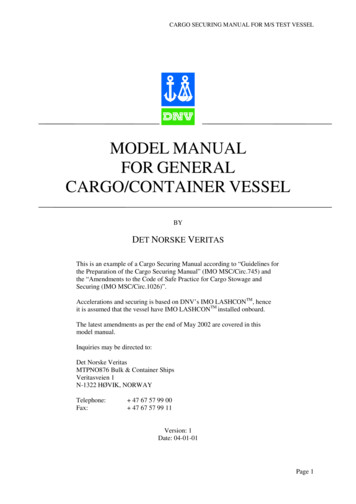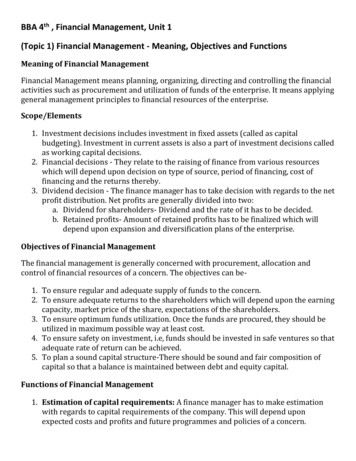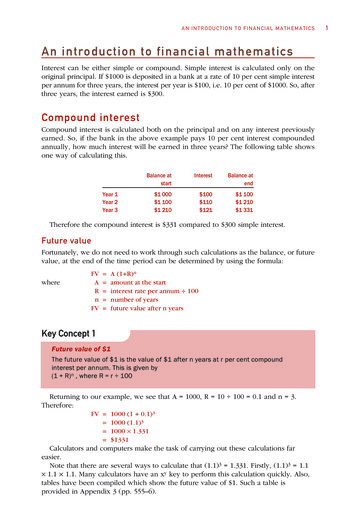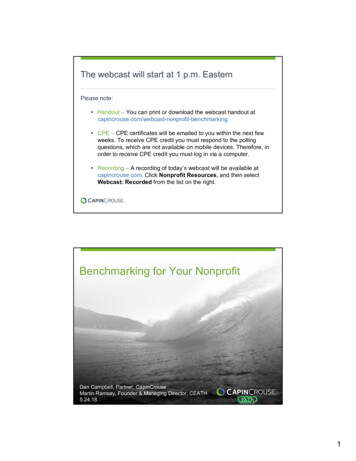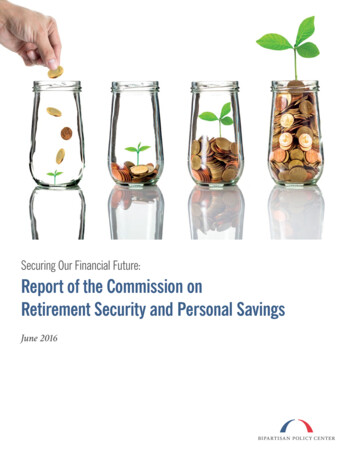
Transcription
Securing Our Financial Future:Report of the Commission onRetirement Security and Personal SavingsJune 2016
Commission on Retirement Security and Personal SavingsKent Conrad, Co-ChairmanDavid DreierFormer U.S. Senator from North DakotaFormer Chairman, U.S. Senate Committee on the BudgetFormer Member, U.S. Senate Committee on FinanceChairman, Annenberg-Dreier CommissionFormer U.S. Representative from CaliforniaFormer Chairman, U.S. House Committee on RulesJames B. Lockhart III, Co-ChairmanGail D. FoslerVice Chairman, WL Ross & Co. LLCFormer Director, Federal Housing Finance AgencyFormer Principal Deputy Commissioner,Social Security AdministrationFormer Executive Director,Pension Benefit Guaranty CorporationTodd F. BarthPresident, Bowers Properties Inc.Former Trustee, Teacher Retirement System of TexasJeff BingamanFormer U.S. Senator from New MexicoFormer Chairman, U.S. Senate Committee on Energy andNatural ResourcesFormer Member, U.S. Senate Committee on Finance andCommittee on Health, Education, Labor, and Pensions (HELP)Charles P. Blahous III, Ph.D.Senior Research Fellow and Director of the Spending andBudget Initiative, Mercatus Center, George Mason UniversityResearch Fellow, Hoover Institution, Stanford UniversityFormer Public Trustee of the Social Security and MedicareTrust FundsPresident, The GailFosler Group LLCFormer President and Chief Economist, The Conference BoardWilliam G. Gale, Ph.D.Co-Director, Urban-Brookings Tax Policy CenterDirector, Retirement Security Project, The Brookings InstitutionTeresa Ghilarducci, Ph.D.Professor, Bernard L. and Irene Schwartz Chair in EconomicPolicy Analysis, The New SchoolDirector, Schwartz Center for Economic Policy Analysis (SCEPA),The New SchoolC. Robert HenriksonFormer Chairman of the Board, President and CEO, MetLife, Inc.Kilolo Kijakazi, Ph.D.*Institute Fellow, Urban InstituteBrigitte C. Madrian, Ph.D.Aetna Professor of Public Policy and Corporate Management,Harvard UniversityRobert D. Reischauer, Ph.D.CEO and Founder, Operation HOPEMember, President’s Advisory Council on Financial Capabilityfor Young AmericansDistinguished Institute Fellow and President Emeritus,Urban InstituteFormer Public Trustee of the Social Security andMedicare Trust FundsFormer Director, Congressional Budget OfficeJames H. DouglasAlan ReutherJohn Hope BryantFormer Governor of VermontExecutive in Residence, Middlebury CollegeMember, BPC Governor’s Council1Former Legislative Director, United Auto Workers*Participated on the commission but chose not to endorse the final report.
Dallas SalisburyResident Fellow and President Emeritus, Employee BenefitResearch InstituteSylvester J. Schieber, Ph.D.Former Chairman, Social Security Advisory BoardIndependent Economic ConsultantAntonio R. Villaraigosa41st Mayor of Los AngelesSenior Fellow, BPCStaffG. William HoaglandSenior Vice PresidentSteve BellSenior Director of Economic PolicyShai AkabasAssociate Director of Economic PolicyBrian CollinsSenior Policy AnalystKenneth MeganPolicy AnalystBen RitzPolicy Analyst2
ACKNOWLEDGMENTSThe commissioners and BPC staff are grateful to the many individuals who assisted our work. Stephen C. Goss, Chief Actuary of theSocial Security Administration, and his team at the Office of the Chief Actuary provided estimates of the impact of the commission’sSocial Security proposals on program finances. Karen Smith, Senior Fellow at the Urban Institute, analyzed the distributional impactsof proposals to reform Social Security and expand access to workplace retirement savings plans using the DYNASIM3 microsimulationmodel. Lisa Mensah served on the commission in 2014 prior to her confirmation as Under Secretary for Rural Development at the U.S.Department of Agriculture. Jack VanDerhei, Research Director of the Employee Benefit Research Institute, provided technical assistanceto the commission. Joshua Gotbaum, Guest Scholar at the Brookings Institution, supplied many useful insights. Numerous otherexperts offered valuable feedback throughout the process. BPC’s Emma Weil provided administrative support during the final stagesof completing this report. Former BPC staff members Alex Gold, Kelly Isom, and Zuzana Jerabek made substantial contributions to thecommission’s work. Jordan Berne, Jack Ramatta, Kelly Turner, and Jillian Zook contributed to this project during their internships at BPC.Marika Tatsutani assisted with editing this report.DISCLAIMERThis report is a product of BPC’s Commission on Retirement Security and Personal Savings. The findings expressed herein are thosesolely of the commission, though no member may be satisfied with every formulation in the report. The findings and recommendationsexpressed herein do not necessarily represent the views or opinions of the Bipartisan Policy Center’s founders or its board of directors.3
Table of Contents5Letter from the Co-Chairmen6Executive Summary14Mission Statement15Introduction17Six Challenges for Retirement Security and Personal Savings38Recommendations:38I. Improve Access to Workplace Retirement Savings Plans56II. Promote Personal Savings for Short-Term Needs and Preserve Retirement Savings for Older Age61III. Facilitate Lifetime-Income Options to Reduce the Risk of Outliving Savings69IV. Facilitate the Use of Home Equity for Retirement Consumption74V. Improve Financial Capability Among All Americans78VI. Strengthen Social Security’s Finances and Modernize the Program101Conclusion: A Comprehensive Package of Proposals to Improve Retirement Security104Appendix:104A. Detailed Policy Specifications114B. Detailed Specifications for Modeling Commission’s Social Security Proposals117C. Measuring and Projecting Retirement Outcomes4
Letter from the Co-ChairmenA large segment of Americans struggle to save for any purpose. Millions are anxious about their preparation for retirement as well as their difficultyaccumulating a savings cushion for short-term unexpected needs. Policymakers are concerned about the consequences of insufficient retirementsavings for individuals, families, and the nation. Recent economic headwinds — stagnating wages and weak economic growth —have heightened these anxieties.The nation’s retirement system has many strengths, but it is also experiencing challenges. Retirement and savings policies have evolved over thedecades into a true public-private partnership. Assets in workplace retirement savings plans and Individual Retirement Accounts (IRAs) havegrown dramatically over the last four decades, but too many Americans are still not preparing adequately. Social Security remains the base offinancial support in old age for most Americans, yet the program faces substantial financing problems. A long history of bipartisanship built thesesystems to promote savings and improve retirement security, but much work lies ahead.To address these challenges, the Bipartisan Policy Center launched the Commission on Retirement Security and Personal Savings in 2014. Overthe last two years, our 19-member commission has carefully reviewed the issues and explored many potential approaches to boost savings andstrengthen retirement security.Members of the commission possess considerable expertise about the U.S. retirement system — including Social Security, employer-sponsoredretirement plans, and personal savings. They have a variety of backgrounds and relevant experiences, including operating businesses andsponsoring employee-benefit plans, administering state and federal government agencies, serving as elected officials, advocating for workers,advising large companies on their retirement plans, and conducting research on savings and retirement policy. We thank them for theircommitment and willingness to find common ground.No relevant policy idea was off limits. Commissioners considered many ways to build on strengths and address weaknesses in savings andretirement security. Our deliberations benefited from extensive modeling simulations, conducted for us by the Urban Institute. They showed theimpact of various policies on savings and income for older Americans. Results of these simulations are included throughout the report.All commissioners came to the Social Security discussions with strongly held views. Therefore, not surprisingly, our Social Security negotiationswere particularly challenging. In the interest of encouraging compromise and informing the public debate, the commissioners operated under therestriction of a roughly 50-50 balance between increased revenues and changes to benefits in future years. Not all commissioners agree with thisconstraint. Some want proposals with more revenues, while others prefer greater changes to benefits compared to current policy. Nevertheless, allsignatories to the recommendations agree that if the constraint of a 50-50 balance between increased revenues and changes to benefits in futureyears is adhered to, then the Social Security package put forward by the commission is a balanced, effective and good set of proposals.We are encouraged that the issues of savings and retirement security have attracted bipartisan interest among business leaders, themedia, elected officials in Congress, the administration, and the states, as well as from candidates seeking public office. We hope thatthe commission’s recommendations will contribute to meaningful action by individuals, businesses and government to achieve a secureretirement future for all Americans.Sincerely,JAMES B. LOCKHART III5KENT CONRAD
Executive SummaryRetirement challenges dominate media headlines and presentpolicymakers with a tremendous opportunity for action. Tectonicshifts in demographics, policy, and the marketplace have transformedthe U.S. retirement landscape. The most profound change has beenan ongoing shift by many employers from defined benefit pensionsto defined contribution plans. As a result, 401(k) — previously anobscure section of the tax code — has become a household name.As average longevity increases, Americans need to save moreor work longer if they hope to maintain their standard of livingduring retirement. While Social Security, the foundation of the U.S.retirement income system, is paying benefits over more retirementyears, the current benefit schedule is underfunded.Given all of these changes and risks, it is no surprise that Americansare anxious about retirement. Many are uncertain about what theyshould do to prepare. As the retirement system evolves, Americansneed up-to-date guidance and better information to navigate a pathto long-term financial security.Workers have found themselves part of a great experiment —one that has given individuals and families far more control andresponsibility for financing their own retirement, and simultaneouslyexposed them to greater risk. Some families are preparingToday, more than in the past, personal responsibility is of centralappropriately, but others struggle to save for retirement while meetingimportance in retirement preparedness — individuals and familiescompeting, and often more-immediate, personal needs related tocan’t afford to take a passive approach to retirement savings — butemergencies, homeownership, and education.that doesn’t mean everyone should be or can be on their own. People6
need the assistance of a well-designed system as they accumulate,invest, and spend down their retirement savings. Public policy has acritical role to play in facilitating savings and a secure retirement.This report presents a comprehensive package of bipartisanproposals to address six key challenges: Many Americans’ inability to access workplaceretirement savings plans; Insufficient personal savings for short-term needs,which too often leads individuals to raid their retirementsavings; Risk of outliving retirement savings; Failure to build and use home equity to supportretirement security; Lack of basic knowledge about personal finance; and P roblems with Social Security, including unsustainablefinances, an outdated program structure and failure toprovide adequate benefits for some retirees.Taken together, the recommendations contained in this report aimto establish a better savings culture and renew the promise of anadequate retirement — across the income spectrum — for currentand future generations of Americans.Improve Access to Workplace RetirementSavings PlansToo many Americans, especially those who work for smallbusinesses, lack access to a payroll-deduction workplace retirementsavings plan. This is partly because offering such plans entailsburdens and costs that employers may be unwilling or unable to bear.We recommend the creation of a new, streamlined option calledRetirement Security Plans that would allow small employers totransfer most responsibilities for operating a retirement savings7plan to a third-party expert, while still maintaining strong employeeprotections. We would also enhance the existing myRA program toprovide a base of coverage for those workers, such as part-time,seasonal, and low-earning workers, who are least likely to beoffered a retirement savings plan.Other workers have access to retirement savings plans but do notcontribute. We propose an alternative to nondiscrimination testingalong with new tax incentives to encourage employers to adoptautomatic enrollment and escalate their employees’ contributionsover time.Once these reforms are in place, we recommend establishing anationwide minimum-coverage standard to pre-empt the patchworkof state-by-state regulation that is already developing. Beginningin 2020, employers with 50 or more employees that do not alreadyoffer a retirement plan that meets certain minimal thresholds wouldbe required to automatically enroll employees into a new RetirementSecurity Plan or myRA. This would ensure broad access to workplaceretirement savings plans while minimizing the burden for employers.Employees would have the ability to change contribution amounts oropt out of contributing entirely.A variety of additional reforms could support greater access toretirement savings plans and improve the experience of planparticipants. We would encourage lower-earning individuals tosave for retirement by improving the existing Saver’s Credit foryounger workers and by exempting some retirement savingsfrom asset tests to qualify individuals for certain federaland state assistance programs. We also recommend severaladditional actions, including the creation of a Retirement SecurityClearinghouse to help Americans consolidate their retirementsavings, steps to limit over-exposure to company stock, andmodest adjustments to retirement tax expenditures.Multiemployer defined benefit plans, which are organized by morethan one employer and a labor union, are experiencing financialchallenges. We recommend the creation of Lifetime Income Plans— a new, more-sustainable retirement-plan design that could
Figure 1. Retirement Savings for Lower- and Middle-Earners Grow Significantly UnderMinimum-Coverage StandardProjected change in retirement savings among individuals aged 62 and older in 2065 under near-universal access to workplace retirement savings.Percentage Difference in Retirement Savings60%50%40%30%20%10%0%Bottom EarningQuintile2nd QuintileMiddle Quintile4th QuintileTop EarningQuintilePosition in Lifetime-Earnings DistributionNote: Retirement savings include savings in defined contribution plans, such as 401(k) plans, IRAs, and Keogh plans, which are available to self-employedindividuals. Population is segmented based on lifetime earnings; for example, the bottom quintile represents those individuals whose total career earnings(including wages and salaries) were in the lowest 20 percent of all Americans. Figure is presented on a per-capita basis, which means that estimates are forindividual persons, assuming that couples equally divide household assets. Modeling assumptions and methods are discussed on page 47.Source: The Urban Institute - DYNASIM3be adopted on a voluntary basis. This new plan design would blendthe strengths of defined benefit and defined contribution plans byincorporating elements of both approaches.Promote Personal Savings for Short-TermNeeds and Preserve Retirement Savings forOlder AgeAmericans need to increase their personal savings so that theyare better positioned to handle emergencies and major purchases.Insufficient short-term savings can lead workers to draw downtheir retirement accounts, incurring taxes and (often) penalties.This “leakage” of retirement savings — while it might addressan immediate financial squeeze — jeopardizes many Americans’long-term retirement security. To address this issue, we recommendclearing barriers that discourage employers from automaticallyenrolling their employees in multiple savings accounts, one for shortterm needs and another for retirement.Some leakage of retirement savings results from system complexityand poorly designed regulation. We propose to ease the process fortransferring savings from plan to plan, because many pre-retirement8
withdrawals occur upon job separation. In addition, early-withdrawalrules and penalties for workplace plans and Individual RetirementArrangements (IRAs) should be harmonized by raising IRA standards.Reduce the Risk of Outliving SavingsLongevity risk, the possibility that retirees will outlive their savings,is a growing and significant threat to retirement security. SocialSecurity, defined benefit pension plans, and life annuities frominsurance companies all leverage the power and efficiency ofmortality pooling to help individuals manage the risk of longevity.Yet many defined benefit plan participants choose a lump-sumdistribution instead of monthly income for life, and few purchase lifeannuities with their retirement savings. While Social Security providesa form of lifetime income, Social Security benefits alone will not beadequate to meet all income needs for most retirees. For those whohave accumulated sufficient savings, other lifetime-income solutionsoffer the security of an added, regular retirement income that theycannot outlive.We recommend that plan sponsors integrate sophisticated but easyto-use lifetime-income features within retirement savings plans.For example, it should be easy for plan participants to purchasea guaranteed lifetime-income product in automatic installments.Plan sponsors could establish a default lifetime-income option oroffer an active-choice framework, in which participants are askedto choose options from a customized menu. In-plan tools could alsohelp participants make an informed decision about when to claimSocial Security benefits and then to schedule withdrawals from theirretirement plan to facilitate later claiming of Social Security benefits.We believe employers need safe harbors to limit their legal risk asthey offer these features and attempt to educate workers aboutlongevity risk and lifetime income.Additionally, we recommend clearing barriers to offering a wider arrayof choices for lifetime income in both retirement savings and pensionplans. In defined contribution plans, participants aged 55 andolder should be allowed to use their retirement savings to purchase9annuities that begin payments later in life. Workers with definedbenefit pensions should be able to receive part of their benefit as alump sum and the rest as monthly income for life, rather than the allor-nothing choice most have today. Also, to encourage participantsto work longer and provide more-consistent work incentives, werecommend allowing employer-sponsored retirement plans to alignplan retirement ages with Social Security.Facilitate the Use of Home Equity forRetirement ConsumptionHousing is an important form of savings. Americans own morethan 12.5 trillion in home equity — a sum that rivals the 14trillion that Americans hold in retirement savings.1, 2 For individualsor couples who lack substantial savings in a retirement plan butwho own their residence, homeownership can be a major sourceof retirement security. A variety of mechanisms exist for tappinghome equity to fund regular consumption needs in retirement; forexample, homeowners can downsize, use a reverse mortgage, or selltheir home and rent instead. These approaches have advantagesand drawbacks; retirees with home equity should be aware of theavailable alternatives and have independent advice to make anappropriate choice for their circumstances.Federal and state tax policy, however, actually subsidizes the use ofhome equity for pre-retirement consumption, leaving many retiredhomeowners burdened with debt and with less equity to supportretirement security. We recommend ending these subsidies byeliminating tax benefits for borrowing that reduces home equity.We also propose to strengthen programs that support and adviseconsumers on reverse mortgages, which can be a good option forsome older Americans. Establishing a low-dollar reverse-mortgageoption would facilitate smaller loans while reducing fees forborrowers and risk for taxpayers.
Improve Financial Capability AmongAll AmericansFinancial capability — defined as having the knowledge, ability,and opportunity to manage one’s own finances — is lacking amongtoo many Americans.3, 4 This is a troubling fact at a time when thenation’s retirement system has transitioned toward greater individualcontrol and responsibility.Exposure to financial knowledge and planning should begin earlyin life, with schools, communities, employers, and federal andstate governments all working to foster a culture of savings and toposition individuals to make prudent financial choices. We supporta variety of approaches, including implementing recommendationsfrom the President’s Advisory Council on Financial Capability,providing improved personal financial education through K-12and higher-education curricula, and better communicating theconsequences of claiming Social Security early. For example,renaming the earliest eligibility age, currently age 62, as the “reducedbenefit age” would better highlight the lower monthly benefits thatresult from early claiming.Strengthen Social Security’s Finances andModernize the ProgramSocial Security provides the income foundation for many olderAmericans, but to maintain that legacy, prompt adjustments to theprogram are needed. For decades, the program’s trustees haveaffirmed the need for changes, noting that Social Security facessignificant financial challenges. In 2015, the trustees recommended“that lawmakers address the projected trust fund shortfalls in atimely way in order to phase in necessary changes gradually and giveworkers and beneficiaries time to adjust to them.”5 Moreover, SocialSecurity has not been updated to reflect a 21st century workforceand society.We recommend adjustments to Social Security’s tax and benefitlevels to 1) reflect changing demographics; 2) better target benefitson those who are most vulnerable in old age, including survivingspouses and workers in low-earning occupations; 3) preservereasonable intra- and inter-generational equity; and 4) more fairlyreward work. Americans ought to know what they stand to gainfrom extending their working lives and claiming benefits later —both of which are highly effective ways for individuals to raise theirretirement income. Clearer work incentives in the Social Securityprogram would increase understanding of these options and promotebetter decisions.What Do “Payable” and “Scheduled” Mean?Under current law, if Social Security’s trust funds areempty, the program cannot spend more on benefits thanit is collecting in revenues. The program’s trustees projectthat savings in the trust funds will be depleted by 2034.6Any proposal to adjust Social Security benefits is typicallycompared with two post-2034 scenarios: scheduledbenefits and payable benefits. These terms are confusingto many. The payable scenario assumes that, once trustfund savings are depleted, benefits will be limited to levelsthat could be financed with funds from existing, dedicatedSocial Security taxes. The scheduled scenario assumesthat benefits will be paid according to the existing benefitformula despite insufficient Social Security tax revenuesto finance these benefits. Under current law, such benefitscannot be paid.Uncertainty about Social Security’s future magnifies the anxiety thatmany Americans experience as they plan and prepare for retirement.That is why any comprehensive effort to improve retirement securitymust shore up and modernize the program.10
Figure 2. Commission’s Social Security Proposals Would Reduce Poverty Among Older AmericansProjected poverty rates among individuals aged 62 and older under various Social Security scenarios: benefits payable under current law,scheduled (but underfinanced) benefits, and the commission’s proposals.Scheduled (Underfinanced) Benefits ScenarioPayable (Fully Financed) Benefits ScenarioCommission Package (Fully Financed)12%Poverty Rate10%8%6%4%2%0%201520252035204520552065Note: The payable scenario assumes that benefits are limited to levels that can be financed with existing, dedicated Social Security taxes. The scheduled scenarioassumes that benefits are somehow paid according to the existing benefit formula despite insufficient Social Security tax revenues to finance these benefits.Source: The Urban Institute - DYNASIM3The good news is that shoring up Social Security is feasible. But,taking the needed actions requires political leadership — and soonerrather than later. The cost of fixing the program grows as correctiveaction is delayed. A package of reforms that balances changes toscheduled benefits, which cannot be financed by current dedicatedtaxes, with changes to revenues would renew the promise of SocialSecurity and reassure Americans that the program will remain strongfor decades to come.11Our recommendations on Social Security, pensions, and other savingscomplement one another in a variety of ways. In particular, themeasures that we have proposed to expand workplace retirementsavings and to reform Social Security would maximize retirementsecurity outcomes. Taken together, our recommendations wouldachieve incomes for older Americans that are above payable-benefitscenarios throughout the lifetime-earnings distribution.
Figure 3. Commission’s Proposals for a Workplace Retirement Savings Minimum-Coverage Standard andSocial Security Reform Would Achieve Incomes for Older Americans At or Above Scheduled Levels for BothLower- and Middle-EarnersProjected average disposable income (in 2015 dollars) among individuals aged 62 and older in 2065 under near-universal access to workplaceretirement savings and implementation of commission’s Social Security proposals.Average Disposable IncomePayable (Fully Financed) Benefits ScenarioCommission Package (Fully Financed)Scheduled (Underfinanced) Benefits Scenario 100,000 90,000 80,000 70,000 60,000 50,000 40,000 30,000 20,000 10,000 0Bottom eTop EarningQuintilePosition in Lifetime-Earnings DistributionNote: Disposable income includes cash income from all sources, such as Social Security benefits and retirement account withdrawals, after subtracting taxes andMedicare premiums. Disposable income does not include cash equivalents from in-kind benefit programs, such as the Supplemental Nutrition Assistance Program(SNAP). The payable scenario assumes that benefits are limited to levels that can be financed with existing, dedicated Social Security taxes. The scheduledscenario assumes that benefits are somehow paid according to the existing benefit formula despite insufficient revenue to finance them. Population is segmentedbased on lifetime earnings; for example, the bottom quintile represents those individuals whose total career earnings (including wages and salaries) were in thelowest 20 percent of all Americans. Figure is presented on a per-capita basis, which means that estimates are for individual persons, assuming that couplesequally divide household income.Source: The Urban Institute - DYNASIM312
Figure 4. Commission’s Proposals for Workplace Retirement Savings Minimum-Coverage Standard and SocialSecurity Reform Would Increase Progressivity and Protect Lower- and Middle-Earners from Abrupt ChangesProjected change in disposable income for individuals aged 62 and older in 2065 under near-universal access to workplace retirement savings andimplementation of commission’s Social Security proposals.Percentage Difference in Disposable IncomeCommission Package Compared to:40%35%30%25%20%15%10%5%0%-5%-10%Bottom EarningQuintilePayable (Fully Financed) Benefits Scenario2ndQuintileMiddleQuintileScheduled (Underfinanced) Benefits Scenario4thQuintileTop EarningQuintilePosition in Lifetime-Earnings DistributionNote: Disposable income includes cash income from all sources, such as Social Security benefits and retirement account withdrawals, after subtracting taxesand Medicare premiums. Disposable income does not include cash equivalents from in-kind benefit programs, such as SNAP. The payable scenario assumes thatbenefits are limited to levels that can be financed with existing, dedicated Social Security taxes. The scheduled scenario assumes that benefits are somehow paidaccording to the existing benefit formula despite insufficient revenue to finance them. Population is segmented based on lifetime earnings; for example, the bottomquintile represents those individuals whose total career earnings (including wages and salaries) were in the lowest 20 percent of all Americans. Figure is presentedon a per-capita basis, which means that estimates are for individual persons, assuming that couples equally divide household income.Source: The Urban Institute - DYNASIM3As Figure 4 shows, these proposals would especially benefitlower earners and would protect Americans across the earningsspectrum from the damaging reductions in old-age income thatwould otherwise result if Social Security benefits were limited tolevels that are payable with existing Social Security taxes.Thus, our r
Six Challenges for Retirement Security and Personal Savings Recommendations: I. Improve Access to Workplace Retirement Savings Plans II. Promote Personal Savings for Short-Term Needs and Preserve Retirement Savings for Older Age III. Facilitate Lifetime-Income Options to Reduce the Risk of Outliving Savings IV.


